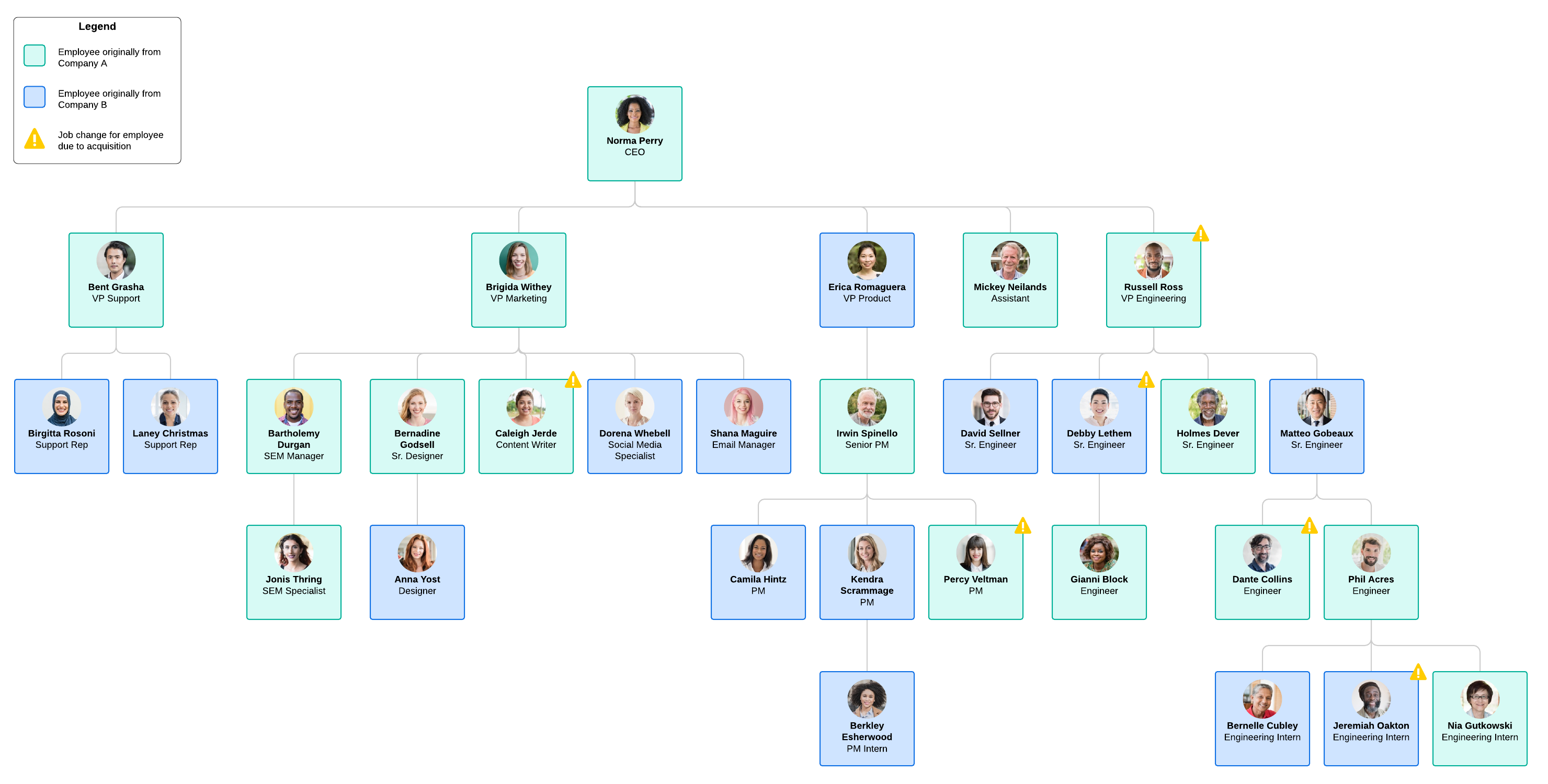
How to prepare employees for mergers and acquisitions
Lucid Content
Reading time: about 7 min
If you’re planning a merger or acquisition, put yourself into the shoes of your employees: learning that your company is being acquired by another company can raise a lot of questions. What will be your place in the new company? Will you take on new responsibilities? Will your job be considered redundant? What opportunities do you have to advance within this new org structure?
To help ease employee fears and doubts, it is important that you understand their feelings. For employees, the M&A is not about the bottom line or growing the business. To them, it’s about wondering if they will fit in the new company and if they will still have a job when the deal is completed.
5 tips to manage the impact of mergers and acquisitions on employees
It is normal for employees to feel apprehensive about mergers and acquisitions. Fear of the unknown is real and can derail productivity. By understanding how employees are affected by M&A, you can work on an integration strategy that will soften the impact during the transition period.
Let’s start with some concerns employees may have, accompanied by tips on how to communicate and prepare your employees to alleviate their fears and help them integrate successfully with the new organization.
1. Keep employees informed during the merger and acquisition process
Imagine walking into the office early one morning because you wanted to get a couple of hours of work done before heading out to the all-hands meeting scheduled at 8:00 a.m. As you walk in, you see a huge banner welcoming the new company you work for.
No one wants to be blindsided by a sudden change to organizational structure. Too often employees don’t find out about mergers and acquisitions until the contracts are signed and the deal is done. A sudden change can leave employees feeling betrayed, angry, and anxious.
To ease anxiety, communicate often with your employees. Give your employees as much information as you can, and keep them up to date. Let them ask questions and answer the questions honestly.
Additionally, find out what employees are feeling and what their concerns are. Meet in groups or one on one—whatever makes your employees comfortable enough to be honest about their concerns.
Create and share a timeline that includes each major milestone of the M&A process. You may not be able to share everything, but the information you can share can be of some comfort to your employees. It is not always enough to just communicate what is happening. You will also need to explain why the M&A is happening. If you can explain how the M&A can possibly be beneficial to them, employees will likely be more receptive to the changes as they come.
2. Create and share your transition plan
A transition plan is key to helping employees from both sides integrate and feel like they are all part of the same company. Transition plans can address items such as new company name, employee email addresses, a workflow to ensure that the acquired company’s employees continue to get their paychecks, and so on.
Similar to our previous suggestion, share these plans with your employees. It’s cliche, but knowledge is power—the more employees know about the transition, the less anxious they will feel.
Use org charts to determine how the two companies will merge together. An org chart gives you a quick and easy-to-read overview of who people are, what their job is, who they report to, which team they belong to, and where they are located. This information can be a big help as you figure out where employees will be moved, how jobs will change, and how the organization will be structured.

Similar to our previous suggestion, share these plans with your employees. Use the org chart as a single source of truth where employees can go to understand their role in the company, where they fit in relation to other teams and departments, and who they can go to for more information.
You may even want to sit down with employees individually and, using the org chart, explain what the transition will look like and how they can continue to grow with the company long-term. Many employees from both organizations may feel like their days are numbered after the M&A process is complete, and you don’t want to lose your best talent because you have left them in the dark.
It’s cliche, but knowledge is power—and the key to easing employee fears.
3. Align company culture
A concern that upper management may overlook is how well the companies will fit together culturally. According to the International Journal of Innovation and Applied Studies, a main reason M&As fail is that the two companies don’t fit together from a cultural perspective.
A lack of understanding about how the employees in the purchasing company think, behave, and work to meet goals and objectives can lead to misunderstanding and miscommunication, which in turn lower productivity as employees are confused about their role in the new organization.
Assess your company’s culture. Culture is far more than benefits and company perks like free bagels every Monday. Evaluate how employees get work done in both companies. Evaluating both work cultures can help you identify where there may be gaps between the two organizations. Use this information during integration planning sessions to determine how the two companies work together as one.
For example, one company may take more time to design and develop new products while the other company moves more quickly. These differences can cause friction down the road if they are not recognized early and prepared for on both sides when the two companies come together.
4. Unify organization objectives and goals
Many times people from the purchasing company come in with an attitude of “we bought you so you are going to do what we say.” This type of attitude can create division between the two companies and keep the two from working together effectively. Teams may be reluctant to share information, training efforts could be stifled, and production could suffer.
Bring the leaders from both organizations together to establish goals and objectives that are beneficial to the entire company and not just the purchasing company. When goals are set without the input of people from the acquired company, they can feel like they are of no worth. Collaborating together and coming to a consensus is a good way to quash any “us versus them” attitudes.
5. Be positive
Throughout the whole process, remain positive. Rumors can fly fast and free. When employees spend too much time worrying about the negative rumors they hear about the M&A or negative news about the company that is acquiring you, it can cause discouragement and can lead to poor productivity.
Do your best to dispel rumors quickly. Keeping everybody up to date with regular and frequent communication can help to keep rumors from taking hold. Make an effort to keep your employees from focusing on negative news so they can remain positive and productive.
Be positive and respectful of the company’s brands, technologies, and reputation. Emphasize the benefits and challenges associated with merging two companies into one. Help your employees realize their worth so they can “sell” themselves to the new company. Keep them positive so they can confidently talk about how their skills and talent will help the new company achieve its goals.
Mergers and acquisitions are a way of life in the corporate world. As of September 2019, there had been 12,713 M&A deals completed in the United States. The impact of mergers and acquisitions can leave employees feeling uneasy and confused about their role in the new company, but keeping the lines of communication open during the M&A process can alleviate apprehension among all employees.
Use org charts and other visuals to help employees understand where they fit into the new organization and help them keep current with information at each stage of the M&A process.

Visualize the future state of your<br> organization to clarify how your<br> companies will merge together.
Read moreAbout Lucidchart
Lucidchart, a cloud-based intelligent diagramming application, is a core component of Lucid Software's Visual Collaboration Suite. This intuitive, cloud-based solution empowers teams to collaborate in real-time to build flowcharts, mockups, UML diagrams, customer journey maps, and more. Lucidchart propels teams forward to build the future faster. Lucid is proud to serve top businesses around the world, including customers such as Google, GE, and NBC Universal, and 99% of the Fortune 500. Lucid partners with industry leaders, including Google, Atlassian, and Microsoft. Since its founding, Lucid has received numerous awards for its products, business, and workplace culture. For more information, visit lucidchart.com.
